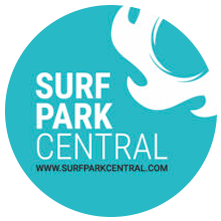Creating Meaningful Surfing Spaces Outside the Ocean
Words by Dr. Jess Ponting
October 4, 2015
Since the first installment of Surf Park Insider much has happened in the world of surf parks – in particular, Surf Snowdonia has happened AND the inclusion of surfing in the 2020 Tokyo Olympic Games is looking very promising.

Rendering of SurfLoch Surf Pools RiF010 project under development in Rotterdam, Netherlands
I had predicted in the lead up to Surf Snowdonia’s opening that the first video footage of a head high 18 second barrel in a pool would change everything. Unfortunately we’ll have to wait and see. While Snowdonia has clearly produced incredibly fun, modest sized Trestles/Inside Macaronis/Greenmount style waves, the barrel remains elusive. In addition, while saying the facility has been plagued with breakdowns since opening would be an overstatement, it is on its third closure in two months. Two mechanical breakdowns and a tear in the lake liner have thwarted would be lake surfers at the rate of 300 per day. A quick read through the comments on Snowdonia’s Facebook announcements suggests that timely communication and service recovery issues may need some attention along with the installation itself. Nobody wants this park to fail, we wish them the best in ironing out these kinks, and respect the balls it takes to go first. I look forward to surfing there in just over two weeks.
With the recent announcement that the Japanese Olympic Committee has given the green light for surfing in the 2020 Tokyo Olympics, the sport is just a full International Olympic Committee session away from being completely official. This historic session will take place during the Rio Olympics in August 2016. It is clear that any Olympic surfing tournament will take place in a surf park. Given this, any country seriously vying for a medal would presumably install the same surf park for its chosen athletes to train in, and this could potentially trickle down through levels of competition to universities and training centers. Heady stuff, but it will require reliable wave technology. Over the next 12 months we will almost certainly see new technologies enter the market from SurfLoch, American Wave Machines (both using pneumatic systems), Kelly Slater Wave Co, and Webber Wave Pools (both using mechanical foil systems like Wavegarden). All conceivably in time to bid for the chosen Olympic technology. Exciting times.
In this installation of Surf Park Insider we hear from Tom Lochtefeld, the visionary behind Flowrider, FlowBarrel, Wave House, and now SurfLoch Surf Pools. The success of FlowRider gives Waveloch the clear edge in terms of sheer numbers of installations (there are hundreds world wide), but Tom is the first to point out that sheet wave surfing is not really surfing. The upcoming RiF010 installation is a SurfLoch SurfPool being built in a disused 12th century canal in Rotterdam. The project was voted into being by the people of Rotterdam and will be operational by summer 2016. While the location and public support for the project make it undeniably cool, the pool itself will be somewhat limited by the dimensions of the canal in relation to its wave action dampening capacities. The first real glimpse of a full scale SurfLoch SurfPool may be in the form of “The Wave”, Bristol which is due to break ground before the end of the year.
This video shows a computer simulation of the actual water motion of the SurfLoch SurfPool currently under development in Rotterdam. Solving for the underlying Navier/Stokes mathematical equations of the fluid flow with the results rendered into the actual environment for added visual realism. To put this into perspective, the simulation of these dynamics are accomplished on a supercomputer performing approximately 5 trillion operations per second, continuously for nearly a month, just to solve the math. The result is an extremely high-realism simulation of the SurfPool under development at the Steigersgracht canal in Rotterdam, Netherlands.
Tom has been dreaming about surf parks and engineering his way towards the ultimate surf pool longer than anyone in the business. With decades of experience in the waterpark space and with literally hundreds of FlowRider installations as well as surf based attractions like the Wave House’s in San Diego, Mallorca, Santiago, and Singapore he is well positioned to comment on what is required to build a meaningful surfing space that is economically sustainable. In this video installment Tom points out the critical importance of having a legitimately perfect wave as part of a surf park, but also the importance of recognizing that the people using the perfect wave are not really the surf park’s primary market. Counterintuitive for sure, but Tom makes a very strong case.

Rendering of the RiF010 Rotterdam SurfLoch SurfPool by Morfis Architecture
























Pingback: What makes a good surf park? | Wave Loch LLC
Pingback: Top 10 Surf Park Stories and Headlines of 2015